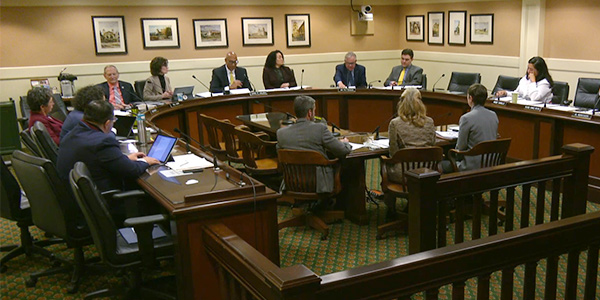By Hudson Sangree
SACRAMENTO, Calif. — Public Utilities Commission President Marybel Batjer told lawmakers Wednesday the commission would move quickly in its efforts to deal with catastrophic wildfires, intentional blackouts and the bankruptcy of the state’s largest utility.
Batjer — an expert on organizational reform, not utilities — said she was trying to get the commission to expeditiously address the crises prior to the state’s 2020 fire season, which starts this summer. (See Newsom Names New CPUC President.)
“Regulators are not known to be nimble. We’re going to be as damn nimble as I can make us for this fire season on many of the things we’re working on,” Batjer told the State Assembly’s Utilities and Energy Committee. Curtailing the power safety power shutoffs that left 2.4 million residents in the dark last October is a top priority, she said.
The committee’s annual CPUC oversight hearing contrasted with last year’s, when then-President Michael Picker said the commission wasn’t the best public entity to address the “enormity” of the state’s wildfire crisis. The commission was set up to deliberate ratemaking, not to handle emergencies, he said.
“I don’t think this is where you’re going to get a sense of urgency,” Picker told the committee. That didn’t go over well with some lawmakers, who got testy with Picker. (See Lawmakers Grill CPUC President on PG&E, Fires.)
Batjer, whom Gov. Gavin Newsom appointed last year when Picker retired, took a different approach under fire. She said the commission has a new Wildfire Safety Division with added staff and is pushing the state’s investor-owned utilities to address safety concerns in their 2020 wildfire mitigation plans, which are required by state law.
Committee Chairman Christopher Holden (D) told Batjer the shutoffs by Pacific Gas and Electric and its failures to communicate with customers had “shattered public confidence” in the utility and state regulators. PG&E’s websites and call centers collapsed under tremendous volume, requiring the CPUC and other state agencies to intervene.
Batjer agreed. “It is critical to uncover what went wrong,” she told the committee. The CPUC wants PG&E and other utilities to take a more geographically “surgical” approach to the intentional blackouts and to balance preventing fires with keeping power flowing.
The commission is working with the utilities to get them to more effectively communicate with the public, emergency responders and local officials, she said. (See California Officials Hammer PG&E over Power Shutoffs.)
PG&E employed the shutoffs broadly in the Sierra Nevada foothills and the state’s coastal areas, trying to prevent wildfires in dry, windy conditions like those that fueled the massive, deadly fires in Northern California wine country in October 2017 and the Camp Fire, which killed 86 people and destroyed more than 14,000 homes in the town of Paradise in November 2018.
Capacity Shortfalls
Holden also criticized the CPUC for failing to anticipate the state’s capacity shortfalls projected to start in 2021. The anticipated shortages “seemed to catch the CPUC by surprise,” he said. (See CAISO, CPUC Warn of ‘Reliability Emergency.’)
It was well known, he said, that coal and natural gas plants were retiring and that solar resources, which begin to go offline during evening peak demand, aren’t yet able to compensate.
“It’s difficult to understand why the CPUC did not appreciate the gravity of the shortfall sooner and take action to mitigate its impact,” the chairman said.
Batjer noted that the commission has required all load-serving entities in California to procure a total of 3,300 MW of new resources on a pro rata basis and recommended some older gas plants remain online through 2023.
The commission is working with CAISO and the California Energy Commission to revise its modeling as the grid is changing, with more wind and solar energy and less electricity to import from other Western states, she said.
“As the system tightens throughout the West due to the retirement of coal- and gas-fired resources, planning assumptions regarding available import of energy and the capacity devoted to California will be tested and will likely need to be continually revised,” she said.
Batjer’s measured, polite responses seemed to mollify Holden and others on the committee, who thanked her for taking on the CPUC presidency, which some described as a thankless task.
Her previous role, as secretary of the Government Operations Agency, was heading a team that came up with ways to reform the Department of Motor Vehicles, notorious for foot-dragging and poor customer service. Her efforts there have been widely praised.
Some lawmakers echoed those sentiments Wednesday.
“I think this was a sterling appointment,” committee Vice Chairman Jim Patterson (R) told Batjer.






